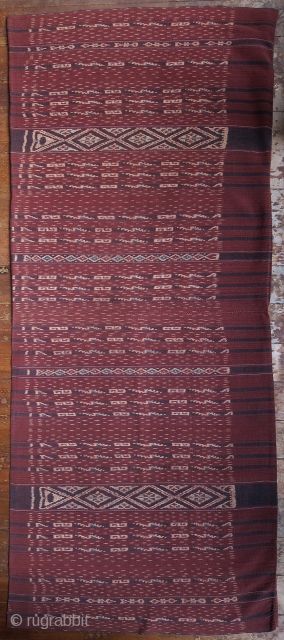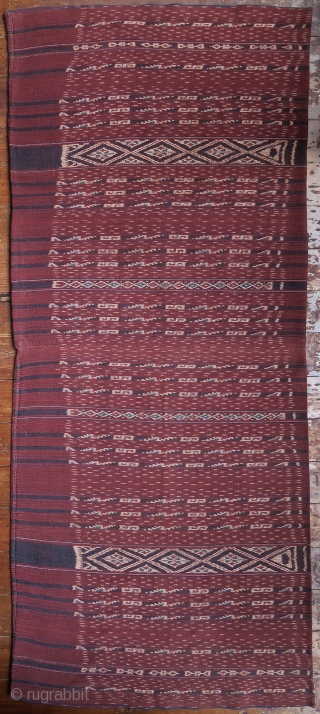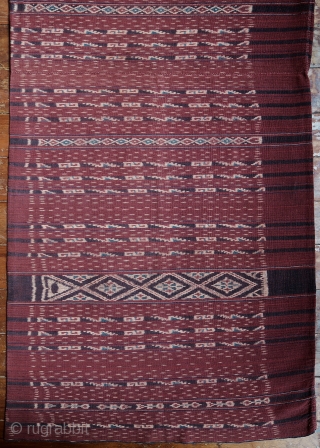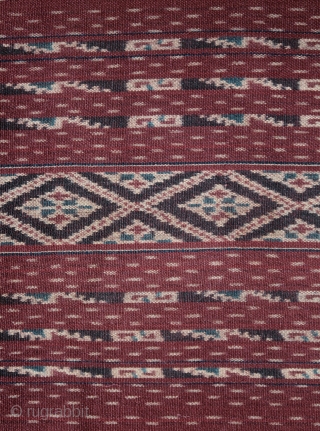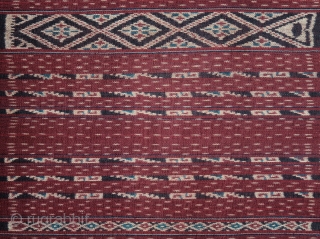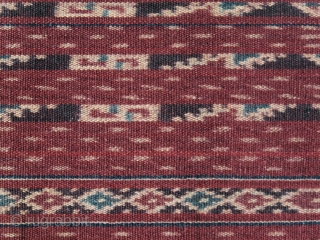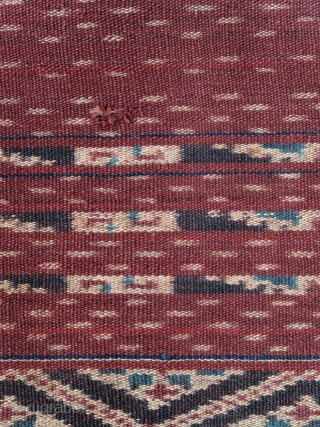Back
Indonesia | Early 20th c Bridewealth Ikat Tubeskirt (Kewatek Méan)
East Flores, Ili Mandiri, Bama, Lamaholot people, 1920 – 1940
Handspun cotton, natural morinda and indigo dyes, warp ikat
Woven in handspun cotton with fine 3-colour ikat bands on a mangosteen red ground, this kewatek méan (woman’s red cloth) is the most prestigious type of the ceremonial cloths made for marriage gift exchanges. It is fully covered in ikat bands executed on an overdyed dark purplish ground, the widest bearing a detailed lozenge motif within a lattice, that is echoed in the string of alternate turquoise and red lozenges in the secondary ikat bands. The narrowest bands carry alternate key and stepped diagonal motifs. Towards the edges is a different secondary band of schematic motifs. In between the 3-colour ikat bands, dash ikat on a mangosteen ground alternates with plain brick red stripes. The combination of different shades provides a rippling field of red which the dark ikat bands both stand out from and blend with.
The skirt is constructed from 2 mirroring panels, joined along the selvedges to form a double width; the fringes were then cut off and the ends sewn together to form a tubular garment. Its subtle colour contrasts and the rhythm of the pattern down the length create an elegant effect, the ikat weaving is very tight, and the whole design harmonious and lively.
Context: Lamaholot textiles are prized for the quality of their ikat. The most elaborately developed and locally differentiated textiles are the women’s cloth that are central components in the ceremonial gift exchanges which bind kin groups together and express their relationship. Given by the bride-givers, in counter-exchange for the men’s goods of an elephant tusk or gong presented by the bride-receivers, bridewealth textiles must be made from locally grown, handspun cotton and dyed with locally procured plant dyes, since there is a very strong symbolic value attached to the bridewealth cloth as an indigenous product. Only cloths where the ikat bands are dyed first in indigo, then over-dyed with morinda (belapit), are suitable for gift exchange. Within Lamaholot textile traditions, primary motifs like those in the main ikat band on this piece were specific to (i.e. owned by) individual lineages. Ruth Barnes, in r. Hamilton ed., Gift of the Cotton Maiden, 1994, 172-74; 175, fig. 8-5 shows a woman wearing this kind of skirt. a very similar example is also illustrated in Ruth Barnes, Ostindonesien im 20. Jahrhundert, 2004, 131, Abb. 137, which has a near-identical format and the turquoise indigo highlights in the main motif.
The tubeskirt is in fine condition, and appears practically unworn; there is one very small tear (see image 6). The colours are deeply saturated and vibrant. The handspun cotton is of medium weight, crisp and slightly stiff, with a rich grainy texture.
Length: 142 cm. Width: 61 cm (stitched); 121 cm (unstitched).
East Flores, Ili Mandiri, Bama, Lamaholot people, 1920 – 1940
Handspun cotton, natural morinda and indigo dyes, warp ikat
Woven in handspun cotton with fine 3-colour ikat bands on a mangosteen red ground, this kewatek méan (woman’s red cloth) is the most prestigious type of the ceremonial cloths made for marriage gift exchanges. It is fully covered in ikat bands executed on an overdyed dark purplish ground, the widest bearing a detailed lozenge motif within a lattice, that is echoed in the string of alternate turquoise and red lozenges in the secondary ikat bands. The narrowest bands carry alternate key and stepped diagonal motifs. Towards the edges is a different secondary band of schematic motifs. In between the 3-colour ikat bands, dash ikat on a mangosteen ground alternates with plain brick red stripes. The combination of different shades provides a rippling field of red which the dark ikat bands both stand out from and blend with.
The skirt is constructed from 2 mirroring panels, joined along the selvedges to form a double width; the fringes were then cut off and the ends sewn together to form a tubular garment. Its subtle colour contrasts and the rhythm of the pattern down the length create an elegant effect, the ikat weaving is very tight, and the whole design harmonious and lively.
Context: Lamaholot textiles are prized for the quality of their ikat. The most elaborately developed and locally differentiated textiles are the women’s cloth that are central components in the ceremonial gift exchanges which bind kin groups together and express their relationship. Given by the bride-givers, in counter-exchange for the men’s goods of an elephant tusk or gong presented by the bride-receivers, bridewealth textiles must be made from locally grown, handspun cotton and dyed with locally procured plant dyes, since there is a very strong symbolic value attached to the bridewealth cloth as an indigenous product. Only cloths where the ikat bands are dyed first in indigo, then over-dyed with morinda (belapit), are suitable for gift exchange. Within Lamaholot textile traditions, primary motifs like those in the main ikat band on this piece were specific to (i.e. owned by) individual lineages. Ruth Barnes, in r. Hamilton ed., Gift of the Cotton Maiden, 1994, 172-74; 175, fig. 8-5 shows a woman wearing this kind of skirt. a very similar example is also illustrated in Ruth Barnes, Ostindonesien im 20. Jahrhundert, 2004, 131, Abb. 137, which has a near-identical format and the turquoise indigo highlights in the main motif.
The tubeskirt is in fine condition, and appears practically unworn; there is one very small tear (see image 6). The colours are deeply saturated and vibrant. The handspun cotton is of medium weight, crisp and slightly stiff, with a rich grainy texture.
Length: 142 cm. Width: 61 cm (stitched); 121 cm (unstitched).
price:
SOLD
- Home
- Antique Rugs by Region
- Category
- Profiles
- Post Items Free
- Albums
- Benaki Museum of Islamic Art
- Budapest: Ottoman Carpets
- Gulbenkian Museum
- Islamic Carpets. Brooklyn
- Islamic Textiles. Brooklyn
- Konya Museum: Rugs
- MKG, Hamburg
- MMA: Caucasian Carpets
- MMA: Mamluk Carpets
- MMA: Mughal Indian Carpets
- MMA: Ottoman Carpets
- MMA: Safavid Persian Carpets
- MMA: Turkmen Rugs
- McCoy Jones Kilims
- Ottoman textiles. Met
- Philadelphia Museum
- Rugs and Carpets: Berlin
- Seljuqs at the Met
- TIEM, Istanbul: Carpets
- V&A: Classical Carpets
- Vakiflar Carpets: Istanbul
- Baluch Rugs: Indianapolis
- Gallery Exhibitions
- Jaf an Exhibition
- Alberto Levi Gallery
- Andean Textile
- Christie's London: 2016
- Francesca Galloway
- HALI at 40
- ICOC Washington, DC 2018
- Jajims of the Shahsavan
- London Islamic Week April, 2018
- Mongolian Felts
- Navajo Rugs: JB Moore
- Persian Piled Weavings
- SF Tribal & Textile Art Show 2020
- SF Tribal 2019
- Sotheby's: C. Alexander
- Turkish Prayer Rugs
- Turkmen Main Carpets ICOC 2007









